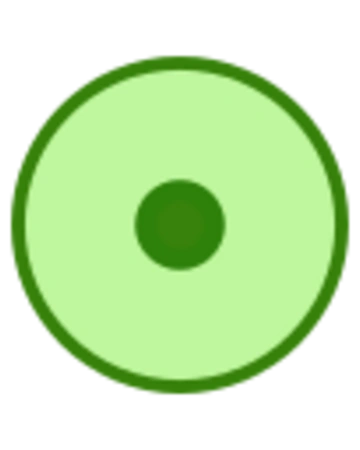Secrocyte is a cell type unlocked after completing "Infection". It has the ability to secrete different substances.
Description[]
The Secrocyte has tiny circles that continuously move outward from the nucleus.
A Secrocyte consume nitrogen continuously, at a rate of 45%/h, If its nitrogen reserve goes below 25%, the Secrocyte would stop secreting and its animation also stops. However, if it gets between 20% and 25%, the Secrocyte would still secrete without consuming nitrogen.
Secrocytes can secrete the followng substances:
- HCN: Diffuses HCN to unprotected cells upon touch.
- Food smell: Cells that smell out uncoated food will be attracted to this.
- Coated food smell: Cells that smell coated food will be attracted to this.
- Light sense activator: Cells that sense sunlight will be attracted to this.
- Wall sense activator: Cells that sense substrate walls will be attracted to this.
- Lipase: Removes fat coating on nutrients. Also damages touching cells.
- Protease: If it touches two cells simultaneously, cuts any adhesin connection between the two cells. Only works if the Secrocyte is at least 0.50 h old.
- -S1: Removes S1 from cells on touch.
- -S2: Removes S2 from cells on touch.
- -S3: Removes S3 from cells on touch.
- -S4: Removes S4 from cells on touch.
- +S1: Adds S1 to cells on touch.
- +S2: Adds S2 to cells on touch.
- +S3: Adds S3 to cells on touch.
- +S4: Adds S4 to cells on touch.
Secrocytes that secrete HCN or lipase are immune to other Secrocytes of the same type.
Secrocytes that secrete food smell, coated food smell, light sense activator, or wall sense activator are invisible to cell-detecting Senseocytes and Stereocytes.
Usage[]
Secrocytes are the center of the Digestion challenges, as well as Deception.
Secrocytes that secrete food smell are often used for tricking smart swimmers into approaching.
Secrocytes that secrete HCN or protease are popular in weapons. Protease is especially popular, as it can disconnect adhesin connections on the defending organism, including even connections to Keratinocytes.
Settings[]
| Settings common to all cell types: |
|---|
|
Note: Settings marked with an asterisk (*) can only be used after completing 26: Slippery Slope.
Child 1:
Child 2:
|
| Settings exclusive to Secrocyte: |
|---|
|
Trivia[]
- Secrocyte used to be unlocked when finishing Scarce Conditions (back when this was required to unlock Deception); this has since changed on the latest update.
- The description of Deception has not been corrected to reflect this; it still implies that the Secrocyte had just been unlocked.
Gallery[]
| Cell | |
|---|---|
| Types | Phagocyte • Flagellocyte • Photocyte • Devorocyte • Lipocyte • Keratinocyte • Buoyocyte • Glueocyte • Virocyte • Nitrocyte • Stereocyte • Senseocyte • Myocyte • Neurocyte • Secrocyte • Stemocyte • Gamete • Ciliocyte |
| Properties | Genome • Age • Mass • Diameter • Adhesin • Nitrates• Toxin • Injury • Tag |

![{\displaystyle {\sqrt[{12}]{10^{-12}}},{\sqrt[{12}]{10^{-11}}},{\sqrt[{12}]{10^{-10}}},\dots ,{\sqrt[{12}]{10^{12}}}}](https://services.fandom.com/mathoid-facade/v1/media/math/render/svg/18dccb3730b0d987fbbdf7a0690408c2d3a1d931)